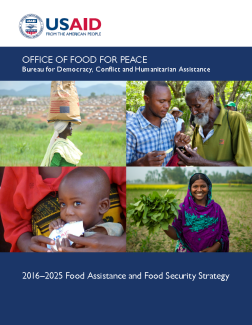Over the past 25 years, the share of the developing world’s population that is undernourished has dropped from 23.3 percent to 12.9 percent, very nearly achieving the Millennium Development Goal (MDG) target of halving the percentage of people suffering from hunger by 2015
Over the past 25 years, the share of the developing world’s population that is undernourished has dropped from 23.3 percent to 12.9 percent, very nearly achieving the Millennium Development Goal (MDG) target of halving the percentage of people suffering from hunger by 2015. However, this global achievement masks wide regional differences and the fact that, in some parts of the world, prolonged conflict, burgeoning populations, and deeply inequitable economic growth are fueling increased hunger and poverty. It is fitting, therefore, as the international community adopts a new set of development targets, and commits itself to addressing the “last-mile” challenges to ending hunger and extreme poverty, that the U.S. Agency for International Development’s (USAID) Office of Food for Peace (FFP) review and update its own strategy and goals. FFP’s new strategy, the 2016–2025 Food Assistance and Food Security Strategy, builds on the FFP 2006–2010 strategic plan, draws on lessons learned during its implementation, and embraces new approaches and tools that have emerged in recent years to increase the impact of U.S. Government (USG) food assistance as a critical tool in global efforts to end hunger and poverty.
The USG remains the largest donor of food assistance in the world, with FFP programming more than $2 billion annually in Title II, International Disaster Assistance (IDA), and Development Assistance (DA) resources to meet both chronic and acute food needs in vulnerable populations. Since FFP’s establishment in 1954, the office has assisted nearly 4 billion people with USG food assistance resources. Over the past decade, as the number of complex conflict and climate-driven emergencies has risen, assistance has become more difficult—and more costly—to provide. Increasing the efficiency and effectiveness of every food assistance dollar and doing more with the resources available has become essential.
The new strategy provides a programming framework that captures the best of what FFP currently does, but challenges FFP and its partners to strive for greater impact with greater efficiency and sustainability. It maintains the vision of the last FFP Strategic Plan, “A world free from hunger and poverty, where people live in dignity, peace, and security,” but broadens the previous goal of reducing food insecurity to one that envisions improving food security and sustaining it. FFP’s goal also embraces “nutrition security”—deliberately signaling the importance of a wide range of nutrition, sanitation, and health factors that, together with the stable availability of and access to nutritious food, contribute to improved food security outcomes.
The strategy’s two key objectives and supporting intermediate results reflect FFP’s increasing focus on affecting change at both an individual and a systems level across the spectrum of its emergency and development activities, and its three corporate objectives ground the framework in strong accountability, learning, and leadership. This ambitious vision recognizes the importance of partnership and collective action to achieve desired results.
FFP’s new strategy:
- Contributes directly to the vision, goal, and objectives of Feed the Future (FTF) — President Obama’s signature initiative to combat global hunger, food insecurity, and malnutrition—and the USG Global Food Security Strategy (GFSS), as called for in the 2016 Global Food Security Act (GFSA).
- Maintains the centrality of the office’s commitment to working with vulnerable groups but recognizes that sustainability requires linkages to community-level and systems-oriented interventions
- Brings clarity to the office’s commitment to supporting good governance by highlighting opportunities to promote social equity and strengthen social accountability
- Strengthens the office’s commitment to providing lifesaving food in crisis settings, adding more-explicit nutrition dimensions in keeping with the growing global understanding of the consequences of malnutrition in the critical “1,000-day window” between pregnancy and a child’s second birthday
- Operationalizes the office’s commitment to providing assistance in ways that reinforce markets and promote dignity and security of beneficiaries
- Reflects a commitment to supporting household, community, and institutional capacities that contribute to resilience and reduce the need for external food assistance
- Reaffirms the office’s commitment to enhancing the productivity of resources held by smallholder producers but recognizes that diversification of livelihoods is the path to resilience for many poor households and that increased income is foundational for transformative change
- Builds on FFP’s commitment to gender equity and its growing understanding of the gender dimensions of food insecurity and the importance of engaging men, women, boys, and girls equitably in the process of advancing female empowerment and their access to economic opportunities
- Embraces a commitment to conflict-sensitive programming, acknowledging the potential of food assistance, like other resource flows, to aggravate social grievances or contribute to other unintended impacts on social cohesion. This commitment also acknowledges that the way that food assistance is delivered can have positive impacts on social cohesion and improve capacities for peace—especially important given that a significant proportion of FFP resources are programmed in contexts of fragility and conflict
FFP’s new strategy embraces the critical role of both in-kind and cash-based food assistance and is crafted to efficiently and effectively implement the authorities provided in the Food for Peace Act of the Farm Bill (the Agricultural Act of 2014) and in Section 7 of the GFSA, which authorizes FFP to implement cash-based food assistance. FFP’s expanded toolkit, which also includes IDA funds from the Foreign Assistance Act, enables it to better contribute to USAID’s mission to end extreme poverty and promote resilient, democratic societies, and to the Bureau for Democracy, Conflict and Humanitarian Assistance’s (DCHA) strategic objectives—most notably “Supporting areas of recurrent crisis to become more resilient” and “Providing timely, effective, and lifesaving humanitarian response.”

